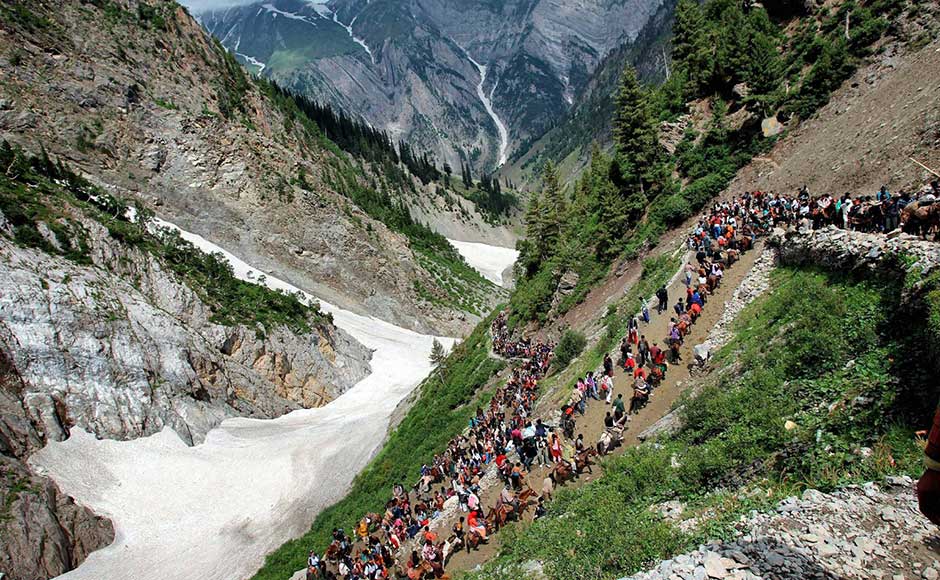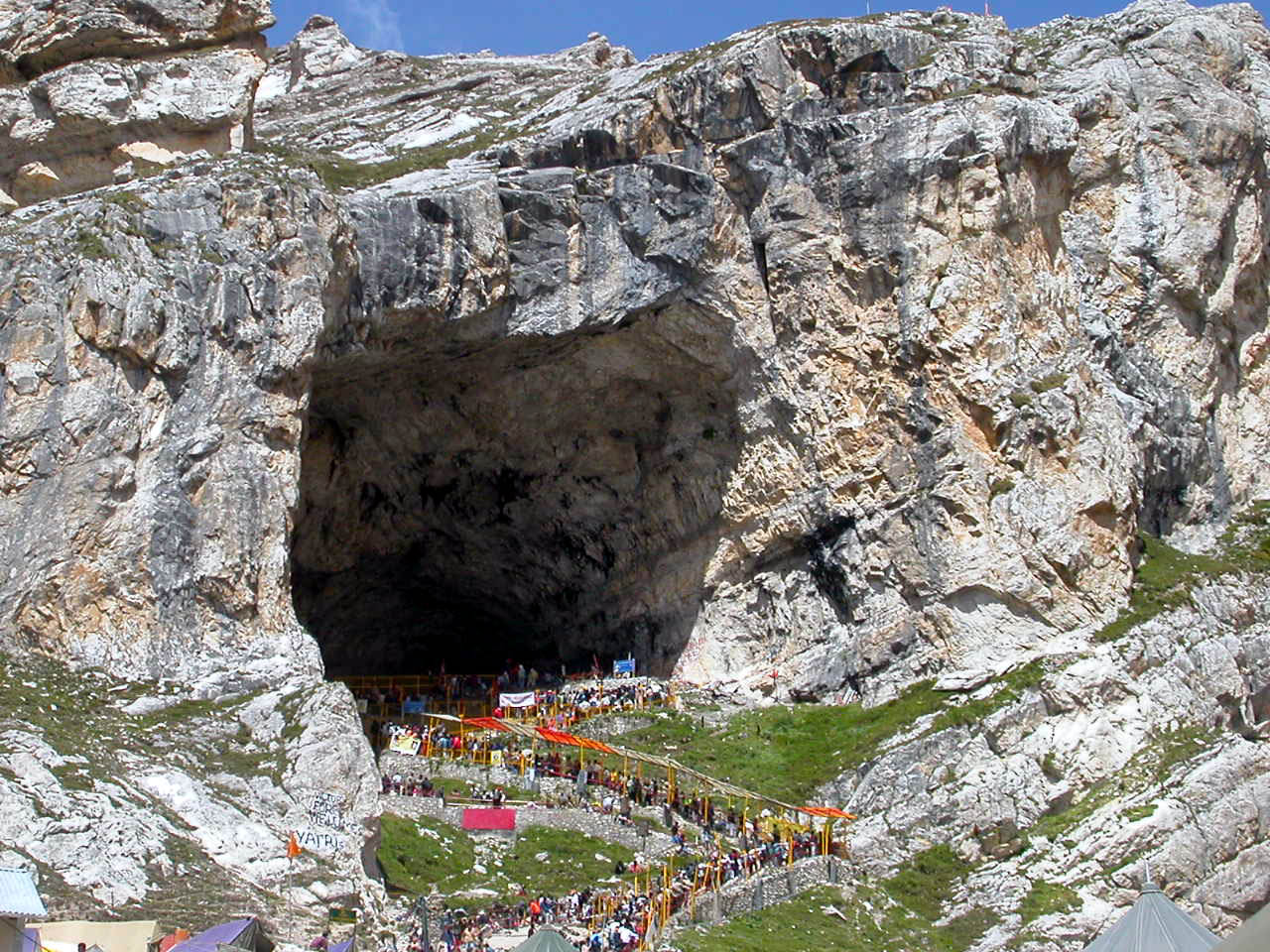Amarnath Temple Anantnag
About Amarnath Temple
Amarnath (Hindi: अमरनाथ गà¥à¤«à¤¾) is a Hindu place of worship situated in Jammu and Kashmir, India. The surrender is arranged at a height of 3,888 m (12,756 ft), around 141 km (88 mi) from Srinagar, the capital of Jammu and Kashmir and came to through Pahalgam town. The holy place frames a critical piece of Hinduism, and is thought to be one of the holiest altars in Hinduism. The give in is encompassed by cold mountains. The surrender itself is secured with snow the majority of the year aside from a brief timeframe in summer when it is open for travelers. A large number of Hindu lovers make a yearly journey to the Amarnath give in on testing bumpy territory to see an ice stalagmite shaped inside the surrender.
Inside the 40 m (130 ft) high Amarnath surrender, the stalagmite is framed because of solidifying of water drops that tumble from the top of the give in on to the floor and grows up vertically from the buckle floor. It is thought to be a Shiva Linga by Hindus. The Cave waxes amid May to August, as snow melts in the Himalayas over the buckle and the resultant water saturates the stones that frame the surrender and bit by bit winds down thereafter. According to the religious convictions, it has been asserted that the lingam develops and contracts with the periods of the moon achieving its stature amid the mid-year celebration, in spite of the fact that there is no logical proof for this belief. As indicated by a Hindu legend, this is the give in where Shiva clarified the mystery of life and forever to his heavenly associate, Parvati. Two other ice developments speak to Parvati and Shiva's child, Ganesha. The fundamental reason for the yearly journey to the give in is love of the ice stalagmite Lingam. It is trusted that after the Middle Ages, this surrender was overlooked by individuals before it was found by a shepherd in the fifteenth century at the end of the day.
Another story identifies with Bhrigu Muni. Long time back it is trusted that The Vale of Kashmir was submerged and Kashyapa Muni depleted it through a progression of waterways and rivulets. Along these lines, when the waters depleted, Bhrigu Muni was the first to have Darshan of Lord Amarnath. From that point, when individuals knew about the Lingam, it turned into a home Lord Bholenath for all devotees and a journey which is finished by lakhs of individuals each year.[8] As we understand Francois Bernier, a French doctor went with Emperor Aurangzeb amid his visit to Kashmir in 1663. In his book "Goes in Mughal Empire" he composes while giving a record the spots he went to in Kashmir that he was "seeking after trip to a cave brimming with magnificent congelations, two days travel from Sangsafed" when he "got insight that my Nawab felt extremely anxious and uneasy by virtue of my long nonappearance". The "cavern" he alludes to is clearly the Amarnath give in as the editorial manager of the second version of the English interpretation of the book, Vincient A. Smith clarifies in his presentation. He composes: "The cavern brimming with superb congelations is the Amarnath give in, where squares of ice, stalagmites framed by trickling water from the rooftop are loved by numerous Hindus who resort here as pictures of Shiva… .."
The sanctuary is a well-known yatra goal for Hindus. Pioneers visit the blessed site amid the 45-day season around the celebration of Shravani Mela in July–August, matching with the Hindu heavenly month of Shraavana. The start of the yearly journey, called Amarnath Yatra is set apart by 'pratham pujan' to conjure the favors of Shri Amarnathji.
Air: The closest airport to Amarnath is Srinagar, located at a distance of around 95 km from Pahalgam, the base camp for Amarnath Yatra.
Rail: The nearest railhead to Amarnath is Jammu, located at a distance of around 315 km from Pahalgam, the base camp for Amarnath Yatra.
Road: It is possible to travel to Amarnath by bus or taxi. Taxis and buses are available for travel from Jammu to Pahalgam (a total distance of 315 km). Buses and taxis can be hired from the Tourist Reception Centre (Jammu and Kashmir Government), located at Raghunath Bazaar (bookings can only be made early in the morning).
The journey by road (walking) passes through Pahalgam to the holy Cave and covers a distance of about 46 kilometres. The distance to be covered from Pahalgam to Amarnath is as follows:
- Pahalgam to Chandanwari - 16 km
- Chandanwari to Pissu Top - 3 km
- Pissu Top to Sheshnag - 12 km
- Sheshnag to Panchtarni - 6 km
- Panchtarni to Holy Cave - 6 km
Many government and non-government, charitable organisations provide tent accommodation and community kitchen (langar) facilities to pilgrims at a very nominal price or at times even free of cost.
- Pahalgam (hill).
- Sonamarg (hill).
- Godsar Lake.
- Betaab valley.
- Baltal valley.
- Baisaran.
- Mamaleshwar shiva temple.
Amarnath is open to vacationers for most time. Be that as it may, the best time to spend a satisfying occasion in Amarnath is amid the winter time. As of now of the year, the climate is lovely and perfect for touring and getting a charge out of the different exercises Amarnath brings to the table. Amid the winter time, you can appreciate the outside exercises without getting dried out or feeling the strings of heat.Best Time to Visit Amarnath - Read most and best prominent time to visit Amarnath, when the climate is brilliant. Look at the greatest month to visit Amarnath, India.
-



